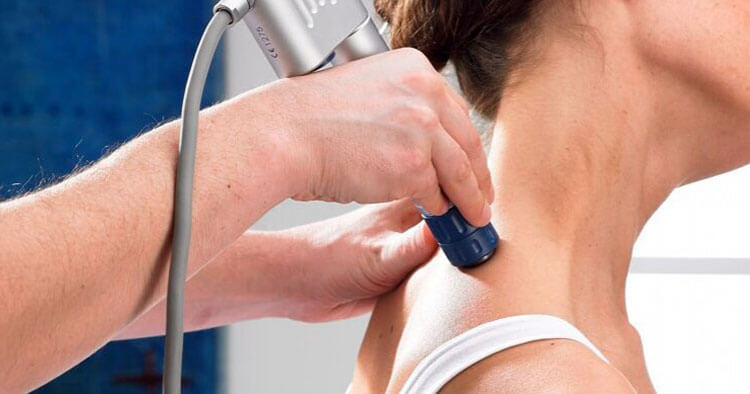Injury Rehabilitation and Training, Muscle Pain and Tendinopathy, Shockwave Therapy, Sports Injuries and Management, Treatment Modalities and Aids
Shockwave Treatment Really Works
How Does Shockwave Treatment Achieve Results?
One of the basic principles behind the way shockwave treatment (ESWT) achieves great results with soft tissue injuries is through the high pressured acoustic shockwaves generated that travel through the skin inducing microtrauma to the target/injured tissue. Subsequently this microtrauma stimulates a healing response in the body, this healing response involves blood vessel formation, improved metabolism, increased delivery of nutrients to the affected area activating cell generation and where appropriate also helps dissolve calcium deposits.
What Are Some Of The Benefits Of Shockwave Treatment?
Shockwave therapy is frequently recommended by specialists, doctors and physiotherapists as a non-invasive last resort therapy prior to the use of minimally invasive injections or surgery. Beyond the obvious benefit of avoiding surgery, hospital admissions, injections and other pharmaceutical medications, some of the benefits of shockwave treatment include:
- An effective therapy with quick results, generally requiring as few as 3-6 treatments to achieve great results.
- Rapid pain reduction, improved mobility and functionality is frequently experienced.
- Natural and non-invasive treatment approach with shockwave therapy helping to stimulates your body’s own healing ability.
- When used appropriately by trained practitioners there are minimal potential side effects.
Are Their Any Precautions Regarding The Use Of Shockwave Therapy?
It is reasonable to consider the use of shockwave therapy for a wide range of musculoskeletal conditions and any potential side effects are minimal. Your physiotherapist will ask some specific questions and assess you regarding the safety and relevance of the therapy. However, if you intend to be considered for shockwave therapy please inform your Sydney Physio Clinic practitioner if you have one of the following conditions, as shockwave therapy may not be appropriate for you if you have one of the following medical conditions:
- Pregnancy
- Diabetes
- Tumor in/or around the treatment area
- Skin wound or acute inflammation in treatment area
- Rupture or significant tear of the tissue or tissues in the treatment area
- Heart or circulatory problems
- Bleeding and blood coagulation disorders and/or taking associated medication like blood thinners
- Received Cortisone injections in the area within 4-6 weeks prior to treatment
Is There Any Evidence Regarding The Use Of Shockwave Treament In Physiotherapy?
The benefits of Shockwave Therapy can be found in numerous well regarded publications including the American Journal of Sports Medicine and the Journal of Orthopaedics. The reports in the literature are somewhat variable, some papers suggesting shockwave treatment achieving a 90% success rate for Plantar Fasciitis (Journal of Orthopedic Research 2003) and 91% success rate for Calcific Rotator Cuff Tendinosis (Journal of the American Medical Association 2005). However, not all patients will be pain free after receiving shockwave therapy, generally the current recommendations for shockwave therapy are that it is a safe treatment for patients who have previously failed conservative measures. It is often suggested that patients try more traditional treatments/physiotherapy for a period of 6 months to a year before considering shockwave therapy. At Sydney Physio Clinic we realise every individual and their complaint is different, accordingly we assess a patients appropriateness for shockwave treatment gauging it on individual circumstances, not exclusively on the duration of symptoms, or failure to respond to classic treatment approaches.
Some other research supporting the use of shockwave therapy includes:
- Rompe, JD, et al. “Low-energy extracorporeal shockwave therapy for painful heel: a prospective controlled single-blind study.” Arch Orthop Trauma Surg. 1998;115:75-9.
- Rompe, JD, et al. “Evaluation of low-energy extracorporeal shock-wave application for treatment of chronic plantar fasciitis.” Jour Bone Joint Surg. 2002;84:335-41.
- Haake, M, et al. “Extracorporeal shock wave therapy for plantar fasciitis: randomized controlled multicentre trial.” Brit Med Jour. 2003;327(7406):75.
- Rompe, JD; Radial Shock Wave Therapy- Where do we stand today?; Translation from Medical Special, Apr 2006
- Furia et al 2007, Extracorporeal shock wave therapy in the treatment of chronic plantar fasciitis and Achilles tendinopathy, Current Opin Orthop 2007; 18: 101- 111
- Rompe et al 2008, Eccentric Loading Compared with Shock Wave treatment for Chronic Insertional Achilles Tendinopathy, J Bone Joint Surg Am 2008; 90: 52-61
- Han et al 2009, Effect of Extracorporeal Shock Wave Therapy on Cultured Tenocytes, Foot and Ankle International, 30: 93-98
It is worth noting that the research around shockwave therapy seems to indicate that as a treatment modality it has better results with certain soft tissue injuries than others, conditions like plantar fascia pain and Achilles tendon pain responding better than patella tendon pain. As a general rule is that shockwave as a treatment approach is becoming more widely accepted and overall the number of relevant treatment applications are increasing with time. Contact us to see if shockwave therpay could be relevant for you.
Think Shockwave Treatment May Be Right For You?
If you feel you are experiencing chronic soft tissue pains that are either constantly reoccurring, or failing to fully resolve then shockwave therapy may be right for you. Sydney Physio Clinic a centrally located CBD physio practice in the centre of Sydney call us on 02 9223 2502 and we will happily arrange you an assessment and treatment session at your convenience.
Disclaimer: This information is provided as an educational service and is not intended to serve as medical advice. Anyone seeking specific medical advice or assistance on Shockwave Treatment Really Works should consult his or her general practitioner, physiotherapist, orthopaedic surgeon or otherwise appropriately skilled practitioner.


